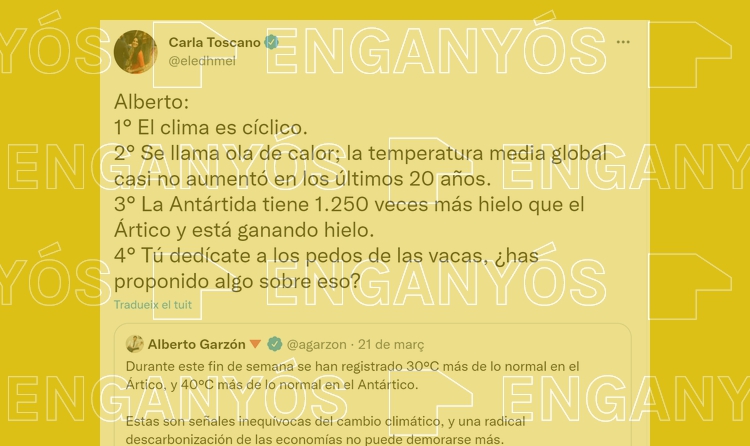It is not true that the heat wave in Antarctica is a consequence of the fact that “climate is cyclical”

We verify a tweet saying that the weather is cyclical and that the temperature has not risen in the last 20 years

Carla Toscano, Vox party MP in the Congress of Deputies of Spain, posted a message on Twitter responding to Alberto Garzon, Minister of Consumer Affairs, with false and misleading information about climate change, including that what is happening in Antarctica is just a heat wave and that the planet’s temperature has not risen in the past 20 years. It is false that temperatures have not risen in the past two decades. Since 1981, global temperature has risen at a pace of 0.18°C per decade. Ever since people started officially recording global temperatures (ca. 1850), the ten warmest years on record have all occurred since 2005 and reports say that the past decade has been the warmest on the instrumental climate record. A heat wave, by contrast, is a weather event characterised by an occasional increase in temperatures. It is, precisely, what is happening in Antarctica, but it is not because temperatures are cyclical.
It’s called a heat wave. The average global temperature has hardly risen in the past 20 years
Contrary to what Toscano says, the past 20 years have actually been “the period of time on Earth in which temperatures have risen fastest”, according to Andreu Escrivá, an environmental scientist with a PhD in Biodiversity and a former member of the Expert Committee on Climate Change of the Valencian government. He is not the only one saying that. Reports from the Intergovernmental Panel on Climate Change (IPCC), the leading scientific body for assessing climate change, concur: according to their most recent report (2021), the temperature has risen more than 1.1°C from 1850-1900 to now. Furthermore, in the past 40 years, temperatures have been rising faster: at a pace of ca. 0.18°C per decade.
“Of course [temperatures] have risen in the past 20 years”, Enric Aguilar (Catalan only), climatologist and head of the Department of Geography at the Rovira i Virgili University in Tarragona (ES), explains to Verificat, enclosing a graphic taken from the Climatic Research Unit of the University of East Anglia (UK), one of the best known research institutions in the field. In the graphic, we can clearly see how temperatures – in the Northern Hemisphere, the Southern Hemisphere and globally – have been rising progressively. What’s more, as indicated by the National Oceanic and Atmospheric Administration (NOAA), the ten warmest years on record to date have occurred since 2005.
In the past few days Antarctica has been experiencing a heat wave, a weather event characterised by three or more consecutive days during which the temperatures are consistently much higher than the average temperatures for those dates of the year. But the fact that there are occasional heat waves does not cancel out the fact that temperatures have been rising. In fact, one of the effects of climate change is precisely the increase in extreme weather events, among them more intense, more frequent and/or longer heat waves (page 4). The frequency of this type of event has increased significantly in the past few years.
The false hiatus that threw climatologists off track ten years ago
The denial of rising global temperatures is grounded in a truth: between 1998 and 2012, the increase in global temperatures slowed down. “The mantra that the temperature has not increased in the past 15, 20, 25 years is rooted in the belief that climate change stopped in 1998, which was a very warm year and slightly distorted the graphs”, Escrivá explains. There were even articles published that entertained the possibility that climate change had stopped. But it was an illusion. “It was later shown, when the math was done a posteriori, that this hiatus actually did not occur, but is a widespread myth”, the expert concludes.
“It was a false hiatus”, Aguilar states. “It had been determined by the local maximum of the El Niño 1997/1998”. The climate expert is referring to a weather event caused by the warming of ocean waters and that periodically disrupts the climate of the planet. It is preceded by a La Niña event, which has similar characteristics but, unlike El Niño, cools the surface of the planet. This, combined with certain volcanic eruptions of the time and relatively low solar activity, caused, as indicated by NOAA, “the rate of average global surface warming from 1998 to 2012 [to be] slower than it had been for two to three decades leading up to it”. But, they add, regardless of this slowing, “the big picture of long-term global warming remained unchanged”.